|
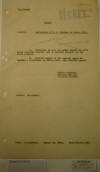
|
1.
Feb. 21, 1930. Secret G-2
Report on Activities of
C. A. Sandino in Mexico City,
Col. Gordon Johnston, Colonel,
Cavalry, Military Attaché,
Report No. 2776,
p. 1.
"G-2 Report ¶ MEXICO ¶ SUBJECT:
Activities of C. A. Sandino in
Mexico City. ¶ 1. Reference is
made to secret report No. 2771
dated February 19, 1930, and to
earlier reports, on the above
subject. ¶ 2. Further report of
the special agent on Sandino’s
activities in Mexico City, are
attached hereto. ¶ Gordon
Johnston, ¶ Colonel, Cavalry, ¶
Military Attaché. ¶ Source: As
stated. ¶ From: M.A.Mexico. ¶
Report No. 2776. ¶ Date: Feb.
21, 1930."
|
|
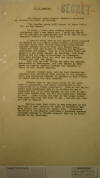
|
2. Feb. 21, 1930.
Secret G-2 Report on Activities of
C. A. Sandino in Mexico City,
Col. Gordon Johnston, Colonel,
Cavalry, Military Attaché,
Report No. 2776,
p. 2.
"C. A. Sandino. ¶ The special
agent reports Sandino’s
movements on February 19, 1930,
as follows: ¶ “The Sandino group
still expect to leave Mexico
City at any moment. ¶ At seven
o’clock this evening Sandino was
in conference with a man whose
name I could not learn; but he
has made an appointment for me
to call at noon tomorrow (Feb.
20) for a long talk. ¶ I learned
today that at the dinner given
recently to Sandino by the
lawyer Isidro Fabela, an
incident occurred which made
Sandino very angry with Fabela.
General Estrada tells me that
this dinner was a ‘frame-up’
with the object of finding out
Sandino’s intentions and plans.
That at this dinner there was
present a man named Moreno, an
American, with whom Sandino had
had some altercations in
Nicaragua; that when Sandino
found out what was up, he became
furious and left the place. ¶
They tell me that Fabela was
once the Mexican Ambassador at
Washington, and that Moreno is
well known in Central America
through his exploits in favor of
Wall Street bankers. ¶ General
Estrada also told me that
Paredes was released this
afternoon from custody of the
authorities, and presented
himself to Sandino at six
o’clock to report how he had
been treated. ¶ Paredes says he
was first taken to the Jefatura
of Operations, and later
transferred to the Guarnición de
la Plaza (Garrison). That at the
latter place they questioned him
as to whether he was a communist
and if he knew anybody on the
list of persons they showed him;
but all the names were unknown
to him. That during the time he
was under arrest they gave him
very bad food to eat, but did
not submit him to torture. ¶
Paredes says that while he was
detained in the Garrison he made
efforts to learn if Pavletich
was also there, but could not
locate him. Therefore
Pavletich’s whereabouts
continues a profound mystery,
although Sandino’s friends
suspect that he is under arrest
at the Garrison."
|
|
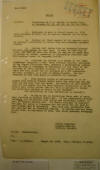
|
3. Feb. 28, 1930.
Secret G-2 Report on Activities
of C. A. Sandino in Mexico City
on February 20, 21, 22, 23, 24,
25, 26, 1930, Gordon Johnston,
Colonel, Cavalry, Military
Attaché, Report No. 2783, p. 1.
"G-2 Report ¶ MEXICO ¶ SUBJECT:
Activities of C. A. Sandino in
Mexico City, on February 20, 21,
22, 23, 24, 25, 26, 1930. ¶ 1.
Reference is made to Secret
Report No. 2776 dated February
21, 1930, and to earlier
reports, on the above subject. ¶
2. Further and final reports of
the special agent on Sandino’s
activities in Mexico City are
forwarded attached hereto. ¶ 3.
Sandino left Mexico City on
Saturday, February 22, 1930 for
Mérida via Vera Cruz. He went to
Vera Cruz by train, and as
reported, left by plane for
Mérida but was not on board when
it arrived at Mérida, according
to information received from the
American Consul at Progreso,
Yucatán. ¶ 4. Attention is
invited to a report of the State
Department (despatch No. 984)
dated February 20, 1930,
addressed to the Chargé
d’affaires here, covering a
conversation between the
Minister of Nicaragua in
Washington and the Chief of the
Division of Latin American
Affairs, to the effect that an
order had been placed for the
purchase of a 300 horsepower
military airplane, by a firm in
Mérida, Yucatán. The presumption
is that this plane is intended
for Sandino. ¶ 5. From another
source of information it is
reported that Sandino visited
Calles about two weeks ago and
was with him for more than two
hours. The results of this
conference are not known, but
the most reliable information is
to the effect that Calles stated
that he “will do nothing to
hamper any activities started in
Mexico to aid Sandino”. ¶ The
reliability of this information
is doubtful. ¶ 6. So far as can
learned, no large sums of money
were received by Sandino while
here. He has approached aviation
officers and ex-General Juan
Merigo and ex-General Arvísu, as
well as ex-General Claudio Fox.
The latter declined to consider
his plan for going to Nicaragua,
but the other two are said to
have looked upon it favorably.
Both have been eliminated from
the Army and are in financial
straits. If Sandino has any
money to pay them, or assurance
of loot, they would probably
accompany him. . . . "
|
|
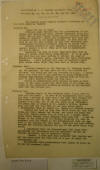
|
4. Feb. 28, 1930.
Secret G-2 Report on Activities of
C. A. Sandino in Mexico City on
February 20, 21, 22, 23, 24, 25,
26, 1930, Gordon Johnston,
Colonel, Cavalry, Military
Attaché, Report No. 2783, p. 2.
" . . . Activities of C. A.
Sandino in Mexico City, ¶
February 20, 21, 22, 23, 24, 25,
and 26, 1930. ¶ The special
agent reports Sandino’s
movements on the above dates as
follows: ¶ February 20: ¶ “Spent
the day as usual. ¶ Everyone
seems worried over the
intervention of the Mexico City
police, and their reserve
increases every day. Martí told
me that Esteban Pavletich, the
Peruvian writer, member of
Sandino’s staff,, who
disappeared some days ago, is
under arrest in the local
garrison. He also told me that
no one had been allowed to talk
with Pavletich, notwithstanding
Sandino’s personal efforts to
secure this. ¶ Sandino promised
to give important information
tomorrow; unable to do so today
as he had an appointment and had
to leave. ¶ Regarding the date
of their departure, they tell me
they are making their final
preparations. It is my opinion
that they are only waiting to
collect the sum of twenty-five
thousand pesos, necessary for
their travelling expenses. I
have noticed that none of
Sandino’s staff have lacked
money while they have been in
Mexico City. ¶ January 21st: ¶
“Sandino remained in his
Balderas St. lodgings nearly all
the morning. He then went out
with Gen. Estrada and others of
his staff, and had not returned
at 8 p.m. I understand they went
out to say good-bye to their
friends and arrange some pending
details, as Paredes told me they
expect to leave tomorrow night
for Vera Cruz. ¶ During my
conversation with Paredes he
told me that while he was under
arrest for three days in the
local garrison he ate absolutely
nothing on account of the
wretched food that was offered
him. ¶ February 22d. ¶ “Sandino
stayed in his lodgings until 1
p.m., when he went out for
lunch. He gave me an appointment
for 4 p.m., but when I arrived
at that hour I was told that
Sandino and his aides had left
at 3:30 in an automobile taking
their luggage with them, but it
was not known by my informant,
the young lady in charge of Dr.
Zepeda’s office, whether they
had left for Vera Cruz or for
some other point. I immediately
tried to locate Dr. Zepeda, but
without success. ¶ Sandino had
told me that they would leave
for Vera Cruz today, and there
embark for Mérida, but since the
train for Vera Cruz leaves
Mexico City at 8:25 p.m. I
cannot understand their leaving
their lodgings when they did. I
was informed in the offices of
Mexican Aviation Co. that no
airplane left for Mérida in the
afternoon, but that one had left
in the morning for that port.
They did not know whether
Sandino had reserved passage for
any of the ports which they
touch. ¶ I understand that the
International Red Cross have
petitioned the Government for
the immediate release of Esteban
Pavletich, one of Sandino’s
aides. ¶ (Later) I have just
been informed that Sandino and
all his aides left for Vera Cruz
at 5 p.m. on board the
Interoceanic Ry. ¶ Gen. Sandino
left instructions with Zepeda to
allow me to see his personal
files. . . . "
|
|
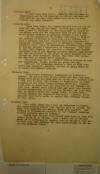
|
5. Feb. 28, 1930.
Secret G-2 Report on Activities of
C. A. Sandino in Mexico City on
February 20, 21, 22, 23, 24, 25,
26, 1930, Gordon Johnston,
Colonel, Cavalry, Military
Attaché, Report No. 2783, p. 3.
" . . . February 23rd: ¶ “I have
been both to Dr. Zepeda’s home
in Lomas de Chapultepec and to
his Balderas St. office, and
have not been able to see him;
they always tell me he is out. I
shall try again tomorrow. ¶
February 24th: ¶ “Same luck
today; Dr. Zepeda has not been
at his office all day, nor at
his home. At 8:30 p.m., the last
time I went to Balderas St. the
young lady in charge of his
office said she was surprised
that he had not come, as he
always attended to patients
between 6 and 8 p.m. ¶ “In the
offices of ‘La Prensa’ they have
no news of the arrival of
Sandino at Vera Cruz or at
Mérida, but said a telegram had
been received from the Congress
Estudiantil (Students’ Congress)
of Monterrey (Mexico) asking
President Ortiz Rubio to
immediately withdraw recognition
of General Moncada’s Government
in Nicaragua. They told me that
said Congress had received a
letter from Sandino informing
them of his campaign against
‘Yankee imperialism’ and that he
trusted in the youth of Latin
America for the triumph of Latin
American ideals; that when that
letter was received it evoked
great applause. ¶ The young lady
in Dr. Zepeda’s office refuses
to give any information, simply
saying she knows nothing. ¶ From
all the foregoing Sandino’s trip
to Vera Cruz would seem
doubtful; possibly instead of
going there he is headed for
Central America.” ¶ February
25th: “It has been absolutely
impossible to locate Dr. Zepeda.
He has not been to his office
all day, and they always tell me
at his home that he is not in.
Neither have I been able to talk
with General De Nogales, who is
still stopping at the Hotel
Regis, although never in.
However, I was able to learn
that the reporter on the
“Prensa”, in Vera Cruz, called
their office here and said that
General Sandino, accompanied by
some of his friends, had left
Vera Cruz on board a train for
Jalapa (State of Vera Cruz),
without stating the object of
his trip. However, it is
probable that he is going to
confer with Governor Tejeda of
that State. ¶ February 26th: ¶
“Not until today was I able to
interview Dr. Zepeda, who
categorically denies that
Sandino went to Jalapa, but says
‘the reporters are seeing Moors
with lances”. (According to
information received by the
‘Prensa’ reporter, Sandino
actually went to Jalapa.) ¶
Zepeda says Sandino will remain
some days in Vera Cruz before
going on to Mérida. When I asked
him if Sandino would go to
Nicaragua he replied that he
couldn’t tell me. He also said
that Sandino had left
instructions to let me see his
personal files."
|
|
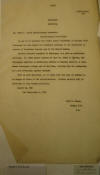
|
6. June
6, 1930. G-2 Report on
Revolutionary Activities in
Nicaragua, Major Fred T. Cruse,
San José, Costa Rica.
"(COPY) ¶ (2657-P-241) ¶ 206 ¶
NICARAGUA ¶ POLITICAL ¶ No.
3020-d – Armed Revolutionary
Movements. ¶ Revolutionary
Activities. ¶ As was to be
expected the recent heavy
withdrawal of Marines from
Nicaragua was the signal for
immediate increase in the
activities of enemies of
President Moncada and of the
United States. ¶ Sandino
returned promptly to Nicaragua,
but with no particular prestige.
Mr. Elio Hasera informs me that
Dr. Pedro J. Zepeda, the
Nicaraguan agitator in Mexico,
has written to Gonzalo Navarro,
a well-known Nicaraguan refugee
now in San Jose, offering him
the leadership of a new
revolution against Moncada. ¶
This is most important, as it
shows that the name of Sandino
is no longer of value to the
revolutionists. Further details
will be forwarded as they become
available. ¶ Report No. 749 ¶
San Jose--June 6, 1930 ¶ Fred T.
Cruse, ¶ Major, G.S. ¶ M.A."
|
|
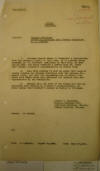
|
7. June
17, 1930.
G-2
Translation of article in
El Dictamen,
Veracruz, 30 May 1930, Capt.
Robert E. Cummings, Assistant
Military Attaché, Mexico City,
p. 1.
"G-2 Report ¶ 3850-a ¶ MEXICO ¶
POLITICAL ¶ SUBJECT: Foreign
Relations: ¶ Status of Relations
with Foreign Countries: ¶ C. A.
Sandino. ¶ 1. Attached hereto
there is forwarded a
translation, from the American
Consul at Vera Cruz, of an
article which appeared in “El
Dictamen” published in that
city, of date May 30, 1930, and
which contains a letter from Dr.
Pedro José Zepeda, Sandino’s
representative in Mexico City. ¶
2. From this article it will be
noted that Augusto Caesar
Sandino has severed relations
with the Mexican Communist
Party, and that his
representative in Mexico City
hints that funds which were
destined for Sandino were
misappropriated by the
Communists. ¶ 3. Judging from
the tone of the letter, and the
accusations made therein by
Sandino’s representative, it
would appear that Sandino’s
career in Mexico is finished. ¶
Robert E. Cummings, ¶ Captain,
Infantry, DOL, ¶ Assistant
Military Attaché, ¶ Acting
Military Attaché ¶ Source: As
stated. ¶ C/p ¶ From:
M.A.Mexico. ¶ Report No. 2948. ¶
Date: June 17, 1930."
|
|
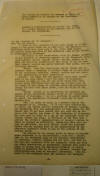
|
8. June 17, 1930.
G-2
Translation of article in
El Dictamen,
Veracruz, 30 May 1930, Capt.
Robert E. Cummings, Assistant
Military Attaché, Mexico City,
p. 2.
"The Attacks on Sandino are
because he would not allow
himself to be managed by the
Communists in Mexico. ¶
Sandino’s representative in
Mexico, Dr. Zepeda, in a letter
replies to the attacks, and in
turn accuses the Communists. ¶
“To the Director of “El
Dictamen” : ¶ Dear Sir and
Friend: ¶ I would be very
grateful if you would cause to
be published in the paper which
you so ably edit, the following
declarations which have been
made by Dr. Pedro José Zepeda,
the general representative of
the defending army of the
National Sovereignty of
Nicaragua: ¶ “By reason of the
accusations which Sr. Hernán
Laborde, in his position of
secretary-general of the
Communist party, made against
General Augusto Caesar Sandino,
permit me to make the following
explanations from which it can
be seen that General Sandino has
never betrayed that party, for
the following reasons: ¶ “First:
When the Association called
‘Hands off Nicaragua’ began a
campaign to collect funds to be
delivered to the Nicaraguan
patriots, General Sandino was
not aware of the connections of
that association. ¶ “Second: The
funds for the purpose, which
were turned over to the army
which I have the honor to
represent, amounted to $250.00;
and all the world knows that
this amount would not serve even
for one day to take care of the
needs of that group of patriots
which has maintained itself for
more than three years, with the
rifle at the shoulder. ¶ “Third:
Having in my possession the
complete archives of the
invincible supreme chief of the
Liberation Movement of
Nicaragua, I am in a position to
answer point by point, the
calumnious statements which may
be made against him. ¶ “Now I am
going to reply in a general way,
to the statements of Sr.
Laborde. It is true that
Constantino F. Martí, the former
private secretary of General
Sandino, was discharged from the
headquarters of that chief, for
the reason that it had been
proved that not only did he not
serve with loyalty the cause of
the defenders of Nicaragua, but
also that he acted as a spy of
the Communist Party in Mexico,
within our army. In addition to
the fact that I possess the
official communications of
General Sandino in which he
advised me officially,
indicating that said notice be
published, the said Colonel
Martí has declared before
various persons that he was
commissioned by the aforesaid
Communist Party to spy on the
actions of our supreme chief. ¶
“In respect to the second point
in which Sr. Laborde makes
reference to my declarations, I
said and I repeat, that in the
defending army of the national
sovereignty of Nicaragua,
General Sandino did not have,
nor does he now have, any
agreement with the Communist
Party nor with any other
association or government,
because this would be equal to
taking away the undisputed
liberty of action which is
necessary for us to carry
forward, without any
interruption, our plan of
National liberation. With
respect to the statement that
our movement has betrayed . . .
"
|
|
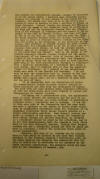
|
9. June 17, 1930.
G-2
Translation of article in
El Dictamen,
Veracruz, 30 May 1930, Capt.
Robert E. Cummings, Assistant
Military Attaché, Mexico City,
p. 3.
" . . . the working and
agricultural classes, whether of
Nicaragua or of the entire
world, I consider such statement
absurd, because our struggle in
this moment is not social but
for autonomy, and during such
time as we do not have a free
nation, it would be useless to
take a position in either of
these subjects. General Sandino
has reasons for believing that
from the bosom of the Communist
Party of Mexico, there had been
put out the calumnious version
that the interruption of the
struggle in Nicaragua, was the
result of the betrayal of our
army by General Sandino, and
they even went so far as to say
that Dr. Carlos León had seen
the check for sixty thousand
dollars which the Mexican
Government had sent in order to
convince General Sandino of the
necessity for giving up the
struggle. As may naturally be
suspected, this produced in
General Sandino the most violent
indignation, but incapacitated
as he was at that time to
disprove this grave charge, he
took the prudent course, leaving
them, as he himself said, “that
they should clean up the filth
they had thrown”. This is the
origin of the letters exchanged
between General Sandino and the
secretary-general of the
Communist Party of Mexico; this
is the origin of the sarcastic
declaration that ‘the Communist
Party of Mexico being the one
from which we have received most
help, in our anti-Imperialistic
struggle in Nicaragua’. This I
likewise underlined, as I
underline that which I said
before, that we received $250.00
from the committee ‘Hands Off
Nicaragua’, as a product of the
collections which were made in
the streets and theaters. I do
not care to make the accusation
that Sr. Laborde or the
Communist Party of Mexico had
taken these funds, but they,
better than anyone else, are in
a position to know what use was
made of them. ¶ “It is
undeniable that the Communists
of Mexico did unmentionable
things to cause General Sandino
to break relations not only with
the Government of Mexico, but
also with all that element which
sincerely affiliated with our
cause, could have given liberty
of action and independence to
General Sandino. ¶ “Following
out a preconceived plan, the
unpleasantness of Martí towards
the newspaper men who came to
interview General Sandino and
which provoked an unfortunate
incident which I personally had
to arrange. It was due to this
same plan of the Communists that
the same Martí was made a
prisoner as the result of having
given utterance to displeasing
statements about the President
of the Republic; utterances
which placed General Sandino in
a highly embarrassing position.
When General Sandino was given
an account of the manner in
which the Communists were acting
through his private secretary,
he resolved in a determined
manner to clear up the
situation, and it is for this,
fundamentally, that the
Communist Party feels that it
has been betrayed, because,
finding that General Sandino was
not a manageable person and that
he could not have in Nicaragua a
motive for agitation which could
be called Communistic. ¶
“However, the fury of Sr.
Laborde can be clearly seen, in
that, while he assured on one
side that Sandino returned to
the struggle obeying a
utilitarian plan, on the other
hand, he was assuring the
Communists that his stay in
Mexico was in obedience to his
purchase by the North American
Imperialism, the purchase which
had been made by the Government
of Moncada, etc. . . . "
|
|
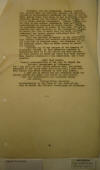
|
10.
June 17, 1930.
G-2
Translation of article in
El Dictamen,
Veracruz, 30 May 1930, Capt.
Robert E. Cummings, Assistant
Military Attaché, Mexico City,
p. 4.
" . . . Resuming, for the
Communists, General Sandino sold
himself when for strategic
reasons and political reasons,
he provisionally abandoned the
field of battle, where during
three long years he had
maintained himself immovable
before all the united forces of
Moncada and of the North
American Government. General
Sandino was not sold to the
Mexican Government; when
materially incapacitated, he
remained in Mérida, Yucatán,
awaiting the opportune moment to
return to his duty; and now it
results also that according to
the communists, he goes to
gamble his life in order that
the North American Government
may secure greater advantages
from the traitor José María
Moncada. ¶ “Like the previous
calumnies, is the observation
that General Sandino has
received certain materials, and
even that he received money, the
fabulous sum of two thousand
pesos, that he might return to
resume the struggle. ¶ “Whatever
may be the charges of the
enemies of Nicaraguan liberty,
we find ourselves resolved to
demonstrate that we do not
follow any base motives, and
that earlier or later, the world
will take account that General
Sandino is a man immaculate, and
a true apostle. ¶ Pedro José
Zepeda. ¶ General Representative
of the Army to defend the
National Sovereignty of
Nicaragua.” ¶ And I beg that you
will kindly publish this, for,
having published in the organ
under your direction, a news
item from Mexico City, which
referred to this same affair. ¶
I send you my thanks for the
attention which the present
letter may merit, and remain at
your orders, ¶ Your most
affectionate and attentive
friend and servant, ¶ Enrique
Rivera Bertrand, ¶
Representative in the State of
Vera Cruz of the Army to defeat
[Defend] the National
Sovereignty of Nicaragua."
|
|
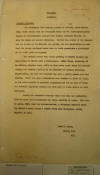
|
11. Jan. 7, 1930.
G-2 Report on Sandino Situation, Major Fred T.
Cruse, Military Attaché, Mexico
City.
"NICARAGUA
¶ POLITICAL ¶ SANDINO SITUATION
¶ The newspapers this morning
publish an article, dated Mexico
City, which states that the
Communist Party and the
Anti-Imperialistic League are
investigating charges that
Sandino accepted $60,000. to
drop his Cause and abandon
Nicaragua. Neither the source of
the charges nor the source of
the $60,000. are stated, but the
declaration is made that the
groups mentioned above have in
their possession a photograph of
the check given to Sandino. ¶
The article states that since
arriving in Mexico Sandino has
been living in Merida like a
millionaire. Señor Ycaza,
Secretary of the Mexican
Legation here, tells me that
every month since his arrival
Sandino has written a letter to
the Governor of Yucatan
demanding 50,000 pesos, but that
the Governor has sent a polite
answer and done nothing. There
are other indications that
Sandino is short of money, so
the above article is probably
propoganda [propaganda] put out
by some of those who formerly
supported Sandino but with whom
he broke before he left
Nicaragua. ¶ During all
Sandino’s campaign there was
only one indication that he
might have accumulated any large
quantity of money. This was in
April, 1928, when his
brother-in-law, a telegraph
operator drawing $60.00 a month
bought a Coffee Finca near
Matagalpa, paying $40,000. in
cash. ¶ Fred T. Cruse, ¶ Major,
G.S. ¶ M.A."
|
|

|
12.
Dec. 12, 1929. "Sandino
Feared Plotting Revolt In
Nicaragua — Exile in Mexico Is
Reported Busy on Plan for Foray;
State Department Silent," New York Tribune.
"Sandino Feared
Plotting Revolt In Nicaragua ¶
Exile in Mexico Is Reported Busy
on Plan for Foray; State
Department Silent ¶
Rumors reaching New York
yesterday indicated the
possibility that Augustino
Caesar Sandino, called “the
Aguinaldo of Nicaragua” was
preparing to return to Nicaragua
from his asylum in Mexico. ¶
Inquiries made by wire from
authorities in Washington and
Mexico City failed to confirm
the report [unreadable]
maintaining a strict silence
upon the subject of Sandino, but
observers in this city were
fearful that the news was
authentic and that events in
Nicaragua were portending. ¶
Gave United States Much Trouble
¶ For almost three years Sandino
defied the armed forces of the
United States, which aggregated
3,500 Marines and included
mountain batteries and
airplanes. And credible word
that he was on his way back to
the country he had sworn to free
of American military forces
would be received with
considerable concern in high
quarters in this country, it was
thought. ¶ Long after his forces
had been dispersed and his
followers reduced to a mere
dozen or so, most of them
generals, Sandino held out in
the fastnesses of the jungle
bordering the Cocos River in the
north of Nicaragua and sent
letters to the Presidents of
South American republics and
even attempted to deal with
President Jose Moncada of
Nicaragua himself. ¶ Sandino was
said to have had not more than a
dozen companions in his swampy
bailiwick when he wrote to
President Irigoyen of Argentina,
suggesting that the latter call
a conference of the
representatives of South
American republics to deal with
the question of American
intervention in Nicaragua. ¶
Suggests Division of Country ¶
Last January he wrote President
Moncada, sending the message by
two of his relatives, suggesting
that they divide Nicaraugua
[Nicaragua] between them.
President Moncada, he wrote,
might keep the seat of
government and the southern part
of the republic and for his
part, he would retain Nueva
Segovia, the province in which
he and his men then were
conducting occasional forays,
often vanishing across the
border into Honduras when
attempts were made to catch up
with him. ¶ Throughout this
period Sandino had strong
support in certain groups in
Tegucigalpa, the capital of
Honduras, and active intrigues
in his behalf were conducted
from that base. He had numerous
admirers also in Mexico,
particularly among the
anti-American faction in that
republic. ¶ According to the
rumors which percolated to New
York, the friends of Sandino in
Honduras, Mexico and other
republics of Central and South
America, have succeeded in
raising funds which may be used
at [as?] a war chest in a new
campaign against the tranquility
of Nicaragua. ¶ No Comment in
Washington ¶ From the Herald
Tribune Washington Bureau ¶
WASHINGTON, Dec. 12.—The State
Department withheld comment
tonight on the report that
Augustino Sandino was plotting
to return to Nicaragua and
resume his anti-American
activities."
|
|
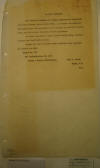
|
13. November 11,
1929. G-2 Report on Sandino Situation,
Major Fred T. Cruse, Military
Attaché, San José.
"SANDINO SITUATION ¶ The
enclosed handbills by Sandino
appeared at Bluefields and
Puerto Cabezas about October
21st. As Sandino was admitted
into Mexico upon his agreement
not to indulge in political
activities, this is a clear
violation of that agreement. ¶
In these circulars he again
attacks Adolfo Díaz, Emiliano
Chamorro and José María Moncada.
¶ Toward the end of October
these circulars also appeared in
Corinto and Léon. ¶ Report No.
559 ¶ San José--November 11,
1929 ¶ Source – Marine
Intelligence ¶ Fred T. Cruse, ¶
Major, G.S. ¶ M.A."
|
|
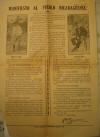
|
14. September 6,
1929. Manifiesto Al
Pueblo Nicaragüense, A. C.
Sandino, Mérida, Yucatán.
"MANIFIESTO AL PUEBLO
NICARAGÜENSE. ¶ Augusto César
Sandino. ¶ Augusto César
Sandino. ¶ ¡ANIMO,
NICARAGÜENSES! ¶ Llego hasta
vosotros con la autoridad de
quien ha sabido aceptar el reto
que el invasor yanqui lanzó al
Ejército Nicaragüense cuando le
vió aniquilado en una guerra
fraguada por el mismo invasor. ¶
¡ANIMO NICARAGÜENSES¡ ¶ Hoy como
ayer, el vínculo de nacionalidad
me dá el derecho de asumir la
responsabilidad de mis actos
ante vosotros y ante la Historia
en el sostenimiento de nuestro
Honor Nacional. ¶ En mayo de
1927, los hijos espúrios de
Nicaragua Adolfo Díaz, Emiliano
Chamorro y José María Moncada,
lograron hacer la confusión
mental del pueblo nicaragüense y
pretendieron obligarle a doblar
su dignidad ante los miserables
invasores yanquis; pero en aquel
momento de claudicaciones y
confusión, la Columna Segoviana
que era a mis órdenes se
convirtió en el Ejército
Defensor de la Soberanía
Nacional de Nicaragua, y ha
rechazado con energía la afrenta
que el gobierno yanqui trató de
imponer al pueblo nicaragüense.
¶ Mientras Nicaragua tenga hijos
que la amen, Nicaragua será
libre. Han sido hijos que la
aman quienes en representación
de todo el pueblo nicaragüense,
la han convertido, de pesadilla
que era para las hermanas
Repúblicas de Latino América, en
la hermana digna de todo aprecio
mediante la lucha que contra la
piratería yanqui entabló aquella
columna el 4 de mayo de 1927. ¶
¡ANIMO NICARAGÜENSES! ¶ Se
acerca la hora de la liberación;
pero en ella sólo estaremos
compactos cuando vosotros sepáis
corresponder al Ejército
Defensor de la Soberanía
Nacional de Nicaragua formando
en sus filas como soldados
dispuesto a todo, inclusive a
dar o recibir la muerte. ¶
¡ANIMO NICARAGÜENSES! ¶ Se
acerca la hora de la liberación.
Ya el invasor levanta el campo
convencido de que el Ejército
defensor de la Soberanía
Nacional de Nicaragua aumenta
cada día y que si sus filas
antes sólo estuvieron en las
Segovias, hoy están en las
ciudades del interior. Cada uno
de vosotros, nicaragüenses, es
un soldado de ese Ejéricto
porque en cada uno de vosotros
se está despertando el amor a la
Patria en la forma de la
dignidad, en la forma de la
energía y en la forma de la
reivindicación. ¶ ¡ANIMO
NICARAGÜENSES! ¶ Ellos, los
bárbaros del Norte, quieren
despedírse de vosotros dejando
sus bofetadas impresas en
vuestros rostros y han visto que
de vuestros rostros mana sangre
ciudadana. Pues, bien, sea; para
que la acción reinvindicadora no
se haga esperar más y para que
se cobre la cuenta golpe por
golpe, ojo por ojo y así sepan
respetar los invasores yanquis
la libertad de los pueblos de
nuestra América, fuertes en la
defensa de sus derechos
soberanos. Jamás se os
perdonaría, nicaragüenses, que
presentárais la otra mejilla al
invasor y vuestras manos deben
ser ciclones que pulvericen a
los descendientes de Walker.
Nuestro Ejército Autonomista,
representativo de nuestro honor
personal y del honor de
Nicaragua como Nación Soberana,
ha probado hasta dónde lleva la
fuerza del derecho contra el
derecho de la fuerza. ¶ ¡ANIMO
NICARAGÜENSES! ¶ Yo estaré con
vosotros en una hora que ya se
acerca. Ya el invasor se amilana
y presiente el peso de la ira
popular. Ya el invasor lia sus
maletas y se retira repartiendo
bofetadas y ya habéis dado
ejemplos de que no presentaréis
la segunda mejilla. Ese es
vuestro deber. ¶ ¡ANIMO
NICARAGÜENSES! ¶ También a los
instrumentos de la intervención
yanqui y a los que la llamaron y
se han empeñado en mantenerla se
les acerca la hora de ajustar
cuentas. A vosotros,
nicaragüenses os toca ir
arreglándolas mientras el
Ejército Defensor de nuestra
Soberanía Nacional reanuda sus
actividades. ¶ No desmayeis. Mi
salida de las Segovias significa
el triunfo absoluto de la
libertad de Nicaragua. El día
que menos lo penséis estaré a
vuestro lado. ¶ ¡NICARAGUA SERA
LIBRE MIENTRAS TENGA HIJOS QUE
LA AMEN! Mérida, Yucatán,
Estados Unidos Mexicanos,
septiembre 6 de 1929. ¶ PATRIA Y
LIBERTAD. ¶ Imprenta y Linotipia
“EL PORVENIR” Calle 64 N 517"
|
|
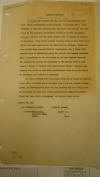
|
15. August 19,
1929. G-2 Report on Sandino
Situation, Major Fred T. Cruse,
Military Attaché, San José.
"SANDINO SITUATION ¶ On August
4th Tenorio sent me a cable from
Honduras which said “Peace
Effectively Re-established. Am
writing you.” This telegram, I
now know resulted from the fact
that Tenorio had just heard of
the capture, by Honduran troops
of Colonel Francisco Estrada.
This is the man that Sandino
left in charge of affairs in
Nicaragua. Four other Sandino
leaders, none of them well known
and 59 men were captured at the
same time as Estrada. These men
have merely been concentrated in
Tegucigalpa, but I agree with
Tenorio that it definitely marks
the end of the Sandino movement.
This is confirmed by the fact
that on the day Sandino heard of
the capture of Estrada he
announced to the papers that he
had bought a Finca in Yucatan
and would remain there. Entirely
reversing his previous insistent
declarations that he would
return to Nicaragua and resume
the campaign. ¶ It seems evident
that the group referred to above
and another large group captured
about the same time were all
genuine Sandinistas, as
distinguished from the two
leaders who were still left in
Nicaragua but who were never
anything but admitted bandits.
These two were Pedro Altomirano
and Miguel Angel Ortez. ¶ Report
No. 486 ¶ San José—Aug. 19, 1929
¶ Source—Newspapers_personal
knowledge. ¶ Fred T. Cruse, ¶
Major G.S. ¶ M.A."
|
|
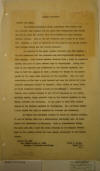
|
16. August 9,
1929. G-2 Report on Sandino
Situation, Major Fred T. Cruse,
Military Attaché, San José.
"SANDINO SITUATION ¶ SANDINO AND
MEXICO ¶ The morning newspapers
state, apparently with Mexico
City as a source, that Sandino
and his group have disappeared
from Merida and are en route for
Belize, with the intention of
again entering Central America.
This is not yet confirmed and I
think it is doubtful. However, I
think it advisable at this time
to sum up the connection between
Mexico and the Sandino movement.
¶ The impetus of the whole
Sandino movement came from
Mexico…not the Government but
the communist and
anti-imperialist groups in that
country. When Gustavo Machado
returned from a visit to
Sandino’s forces last year he
spent several days in
Tegucigalpa. During this time he
was received and entertained at
the Mexican Legation, and when
he left for Amapala to take a
steamer for Mexico he was
accompanied by Mr. Saenz Rico
Secretary of the Legation. This
was most astonishing as for over
a year Machado had been the
editor of a communistic
newspaper called “El Machete”,
every column of every issue of
which contained vicious attacks
on the Mexican Government.
Finally when Sandino decided to
get out of Nicaragua he was
given, entirely openly, every
possible help by the Mexican
Legation in Honduras, Salvador
and Guatemala. On the night of
June 20th Sandino stayed at the
Mexican Legation in Tegucigalpa.
In a previous report I have
stated the help he received in
Salvador and Guatemala. ¶ If
Mexico has permitted Sandino to
return to Central America, it
can be nothing else but a
deliberately unfriendly act, at
least toward the Government of
Nicaragua. From my observations
during the last year and a half
the whole attitude of the
Mexican Government in the
Sandino affair has been openly
unfriendly to the United States.
¶ Report No. 483 ¶ San
José--August 9, 1929 ¶ Sources –
Personal knowledge ¶ Fred T.
Cruse, ¶ Major G.S. ¶ M.A."
|
|
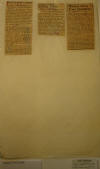
|
17. Aug-Sept 1929.
Press clippings: August 4,
1929, "Mexico To Deport
Sandino," New York Times. ca.
August 13, 1929, "Sandino is
Back In Merida, Yucatan,"
New York Sun.
ca. September 8, 1929,
"Marines Arrive From Nicaragua,"
New York Herald.
"MEXICO TO DEPORT
SANDINO ¶ Nicaraguan Rebel and
Followers to Be Interned in
British Honduras. ¶
MERIDA, Yucatan, Aug. [3 or 8]
(.P).— General Augustino
Sandino, fugitive Nicaraguan
insurgent chieftain, and his
entourage have been sent from
this city to Valladolid, where
it was said here, they will be
sent to Belize, British
Honduras, for internment. ¶
Socrates Sandino, brother of the
Nicaraguan leader, embarked
yesterday for Vera Cruz aboard
the American steamer Mexico. ¶
The Mexican Government early in
the Summer gave General Sandino
and his companions the privilege
of political asylum in Mexico,
granting a temporary residence
of six months in Merida,
Yucatan. ¶ From the time of his
arrival at Vera Cruz General
Sandino made utterances
announcing continuance of his
opposition to the United States
and said he resided in Mexico
only temporarily until he could
recoup his fortunes and begin
his military campaign against
the marines in Nicaragua anew. ¶
His men were all well armed.
There has been no word from
Mexico City as to any further
action by the Mexican
Government. The wording of the
Merida dispatch, which might
indicate the former insurgents
were under arrest, was
unexplained. ¶ Sandino
Is Back In Merida, Yucatan
¶ MERIDA, Yucatan, Mexico, Aug.
[tear in paper]
(A.P.).—Augustino Sandino,
former Nicaraguan insurgent
leader, has returned to Merida
after a brief stay at Tizimin.
He was accompanied here by his
Mexico City representative, Dr.
Pedro Jose Zepeda. ¶ The
Nicaraguan, whom it was thought
here had been informed he must
leave Yucatan, told the Diario
de Yucatan, Merida newspaper, he
had resolved to remain in this
State and become a famer with
other members of his former army
arriving soon. He said he hoped
some day Nicaragua would be
free, prosperous and happy. ¶
Marines Arrive From
Nicaragua ¶ Seven
hundred and thirty-three United
States Marines, all of whom saw
recent service in Nicaragua as
part of this country’s effort to
capture the rebel, General
Sandino, arrived at the
Quantico, Va., Marine base
yesterday afternoon aboard the
U. S. Army transport Henderson.
¶ A small detachment left the
transport for duty at Quantico
and another detachment,
numbering 54 men, left the ship
last night for duty at
Charleston, S. C. The rest will
remain aboard ship until the
Henderson sails September 14,
for China, stopping at various
Marine posts along the Atlantic
coast to discharge other
detachments. ¶ The arrivals all
are members of the Eleventh
regiment, organized from
detachments recruited from
various Marine posts throughout
the world for service in
Nicaragua. The Marines were
reported as being in splendid
condition despite the arduous
campaign and adventures many
participated in during their
stay in the turbulent Central
American republic."
|
|
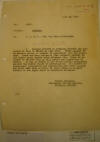
|
18.
July 23, 1929. G-2 Report
on Sandino, Lt. Col.
Gordon Johnston, Military
Attaché, Mexico City.
"July
23, 1929 ¶ No.- 2507. ¶ Subject:
Sandino. ¶ To: A. C. of S., G-2,
War Dept., Washington ¶ 1.
Sandino arrived at Progreso,
Yucatán and proceeded at once to
Mérida, on July 11th. There
appears to be nothing worthy of
comment in connection with his
reception. There was more
curiosity than interest evident
in the rather small crowds which
welcomed him. There is no reason
to believe that he will create
any impression in Mexico. He may
be useful in the future, should
propaganda against the United
States be advantageous. His
rather insignificant
personality, and insincerity,
will tell against him still more
when he tries to raise money to
support himself in the style
which he considers suitable. ¶
Gordon Johnston, ¶ Lieutenant
Colonel, Cavalry ¶ Military
Attaché. ¶ J/p"
|
|
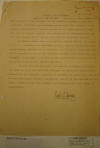
|
19. July 23, 1929.
G-2 Report on Sandino and the Canal, Major
Fred T. Cruse,
Military Attaché,
San José.
"SANDINO AND THE CANAL. ¶ The
substance of the editorial in
the attached clipping is that
the withdrawal of Sandino from
Nicaragua removes the last
obstacle to the complete
subjugation of Central America
by the United States. It says
this will be brought about by
the building of the Nicaragua
Canal and that with Sandino out
of the way this will be
undertaken at once. ¶ It further
states that as a fighting
patriot Sandino has proved to be
of no importance at all, indeed,
judging from his appearance as
he passed through Salvador he is
something of a burlesque
soldier, but that had he
remained defiant in the
mountains he might have caused
the construction of the Canal to
be held up for years, thereby
proving himself the greatest man
Central America has known. ¶ It
ends with the statement that now
all is over, as the minute the
Canal is begun not only will
Nicaragua be completely under
Yankee control, but the
adjoining republics of Honduras
and Costa Rica will also be
compelled, simply through
proximity, to conform to the
dictates of the United States,
leaving only Salvador and
Guatemala with some claim to
independence. ¶ Fred T. Cruse, ¶
M.A."
|
|
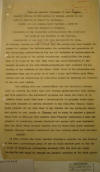
|
21.
June 24, 1929.
G-2 Translation of San Salvador Newspaper, "Complete Details of the Arrival
of General Sandino in San
Salvador Enroute to Mexico Via
Guatemala - Sandino and His
General Staff Traveled a Month
to Reach the Frontier of
Honduras - Statements By the
Celebrated Warrior - Repeats the
Principles For Which He Was
Fighting In the Segovias -
Description of His Trip with
Full Information of It All,"
Diario del Salvador,
San Salvador, p. 1.
"From San Salvador Newspaper of
June 24, 1929. ¶ COMPLETE
DETAILS OF THE ARRIVAL OF
GENERAL SANDINO IN SAN SALVADOR
ENROUTE TO MEXICO VIA GUATEMALA.
¶ SANDINO AND HIS GENERAL STAFF
TRAVELED A MONTH TO REACH THE
FRONTIER OF HONDURAS. ¶
STATEMENTS BY THE CELEBRATED
WARRIOR. REPEATS THE PRINCIPLES
FOR WHICH HE WAS FIGHTING IN THE
SEGOVIAS. ¶ DESCRIPTION OF HIS
TRIP WITH FULL INFORMATION OF IT
ALL. ¶ On Saturday morning at
nine o’clock very few people
knew that Sandino in person had
reached San Salvador, under the
protection and guarantees of the
Salvadorean authorities, on his
way via Guatemala to Mexico,
where he will be the guest of
the latter neighboring republic.
Very few people knew it in spite
of the fact that there was great
excitement in the eastern
section of the city. Police,
soldiers, and cars awakened the
curiosity of the dwellers on the
street which leads to Los
Encuentros and Aculhuaca--What
can be going on on such a rainy
day?--There goes Gómez
Zarate!-one men remarked, as an
automobile passed by carrying
the Minister of War and some
others. ¶ But nothing more was
learned. There was the strictest
privacy. Some one started the
rumor that some Mexican
globe-trotters were coming and
this satisfied the curious. If
everyone had known the truth it
is probable there would have
been a demonstration of sympathy
which might well have resulted
in serious disorder in the city.
Even General Claramount himself
did not know that it was Sandino
who was coming. He simply had
orders to post guards at
Ilopango and be ready to receive
a special train from La Union,
so when someone said-“General
Claramount, I have the pleasure
of presenting General
Sandino”--he nearly fell over
backward. When the train which
brought Sandino from La
Union-(ten hours
enroute)-reached Ilopango
General Claramount had been
waiting about half an hour. ¶
SANDINO. ¶ At
nine o’clock the train reached
Ilopango. A special car was
coupled on the end. A
picturesque group of men in
field uniform gave to the car a
touch of brightness contrasting
strongly with the dull and rainy
morning. The men began to
descend and glances centered on
the more grace- . . . "
|
|
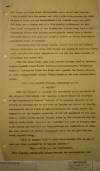
|
22.
June 24, 1929.
G-2 Translation of "Complete Details of the Arrival
of General Sandino in San
Salvador," p. 2.
" . . . -ful figure of a man
about thirty-three years old. It
was Sandino. A tan colored felt
hat, peaked and with a wide
brim, covered his head. He wore
a black and red handkerchief
tied loosely round his neck. His
shirt was a woolen one of a wide
checked pattern, and he wore
high laced riding-boots of tan
leather. Two pistols hung from a
belt completely filled with
shining cartridges. He looked
like a hunter. His clean-shaven
face, pale, and slightly pitted
as though from smallpox, showed
signs of fatigue. ¶ Descending
from the train Sandino removed
his hat and saluted General
Claramount and those with him.
No one remembers what his first
words were. But the first
impression of all was the
same--Sandino is an affable and
modest man. ¶ From the train
there came with Sandino Captain
José de Paredes, Mexican:
Agustín F. Martí-(not
Martinez)-Salvadorean, from
Tectepeque: Gregorio Gilbert,
who fired the first shot against
the Yankee Marines in Santo
Domingo: Rubén Ardilla Gómez,
Colombian and Juan Medrano,
Nicaraguan. ¶ COULD HAVE
BROUGHT COMRADES FROM EVERY
NATION OF AMERICA. ¶
From the station at Ilopango the
mysterious group proceeded to
the Aviation Field. There they
remained a short while. The
secretary of the Confederated
Workers’ Society of El Salvador
happened to be working in
Ilopango, and he sat down by
Sandino and talked to him. The
conversation was at first of
generalities, but who could
resist the temptation to ask
Sandino something of his own
exploits? At the same time it
seemed better to let Sandino
bring up the subject. We had not
long to wait. Sandino told how
his secretary had gone to
Managua many times during the
conflict and that, although the
authorities of Managua were
unaware of it, many Nicaraguans
knew him and gave his man every
possible help. ¶ Later on
Sandino said-“I could have
brought with me men of each and
every nationality in Spanish
America.” ¶ WHILE
WAITING FOR THE TRACK-MOTOR.
¶ From Ilopango Sandino, his
companions, and the accompanying
Army . . . "
|
|
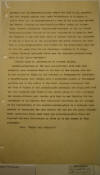
|
23.
June 24, 1929.
G-2 Translation of "Complete Details of the Arrival
of General Sandino in San
Salvador," p. 3.
" . . . officers left in
automobiles, going toward the
city of San Salvador. But they
stopped enroute near Aguas
Calientes, or to be exact, a
little above the Ice Factory.
Here, at a bend in the road,
were waiting the Mexican
Minister and Mrs. Urquidi, Dr.
Gómez Zarate and others. Among
themwere [them were] Dr. Herrera
Gonzales, sub-Secretary of War
and Daniel Montalvo, Executive
Officer of the same Ministry. It
is probably that the Minister of
War felt that since an eminent
warrior was concerned it was up
to them to do the honors. Here
the party remained for more than
an hour, chatting, while they
waited for the track-motor that
was to take the party from the
Los Encuentros crossing to El
Congo. A Señora Teodocia Ayala,
who lives near the spot, saw
pictures being taken of the
“globe-trotters.” ¶
SANDINO WANTS NO INTERVENTION OF
FOREIGN MARINES. ¶
Sandino, accustomed to the open
air, conversed with much more
animation when outdoors. There
at the bend in the road, he told
how he had decided to fight for
the autonomy of Nicaragua. Our
informant, a chauffeur, says
that Sandino gave a historical
sketch of Nicaraguan politics
and of the action of the North
American government from the
time of Walker to the present.
Quite naturally and simply, but
with the same emphasis with
which he has spoken since he
first denounced the
Moncada-Stimson pact Sandino
said that he was fighting for
the withdrawal of the Marines
from Nicaraguan territory and
the triumph of the Constitution
of his country. Sandino, afoot
on a Salvador road enroute to
Mexico, was the same Sandino who
has for two years consistently
maintained those same ideas and
principles, while those who
reproach him have about-faced as
often as it has seemed to them
advisable. ¶ From “Diario del
Salvador."
|
|
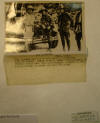
|
23.
June, 1929. G-2
Report on "Gen
Sandino and his staff enroute to
Mexico."
Caption: "Left to right:
Ruben Ardilla Gomez
(Venezuelan), José Paredes
(Mexican), Gen. A. C. Sandino,
Augustin F. Marti (Salvadorean)
Gregorio Gilbert (Haitian)."
|
|
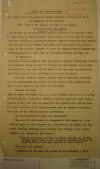
|
24.
June 23, 1920. G-2
Translation of a San Salvador Paper, "The Fight
Against the American Marines
Continues in Full Activity In
the Mountains of the Segovias -
Pedro Ponce Is the General In
Chief of the Rebels - General
Sandino Will Return - In the
Next Dry Season He Will Return
To Nicaragua To Continue the
Fight," p. 1.
"LA
UNION - 22nd of June - Yesterday
there arrived at this port the
launch "Lempira" bringing as
passengers General Augusto C.
Sandino and ten leaders and
officers of his General Staff.
They were accompanied from
Tegucigalpa by the Director
General of Police of Honduras,
General Maximiliano Vasquez,
who, after a short stay in this
port, returned the same day.
¶ AN INTERVIEW. ¶
At seven in the evening we went
to interview General Sandino,
who received us smiling, as
though we were old friends.
At the entrance to the room he
occupied in the Hotel Italia
three of his men were on guard.
They wore khaki-colored field
uniforms and carried revolvers.
¶ The first words of
General Sandino were of
brotherly affection for the
Salvadoreans and praise for the
press of the country, which has
so well backed up his labor of
patriotism. ¶
Enroute to Paris. ¶
When we asked him - "Where will
your trip end?" - he replied: -
"I am going to Mexico, where I
have many friends. I will be
there for eight days, talking
things over with my supporters
and giving some instructions,
and then I will go on to Paris,
together with my brother
Sócrates, to take part in the
Anti-Imperialist Conference."
¶ "Is the remainder of
your army disbanded?" ¶
"No. - and it will never be
disbanded. It will remain
on a war footing until we have
secured the evacuation of my
country by the North American
Marines. At the present
time General Pedro Ponce -
Pedrón - is in command of the
troops." ¶ (Note by M. A.
[Military Attaché]: Since
arriving in Mexico Sandino has
stated several times that he
left Colonel Francisco Estrada
in command. This is the only
mention of Pedro Ponce.) ¶
"When will you return?"
"Certainly in the next dry
season. In the meantime I left
my ... "
|
|
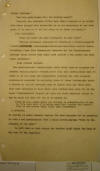
|
25.
June 23, 1920. G-2
Translation of a San Salvador Paper, "The Fight
Against the American Marines
Continues in Full Activity In
the Mountains of the Segovias,"
p. 2.
"
. . . troops fighting.” ¶ “And
were your losses from the
bombing heavy?” ¶ “Recently the
Americans killed more than a
hundred of my cattle with bombs
dropped from planes: but as we
are accustomed to eat even grass
if we have to it did not worry
us or lower our morale.” ¶
MANY FOREIGNERS.
¶ “They say there are many
foreigners in your Army?” ¶
“Well-my principal aide, José de
Paredes, is a Mexican: Agustín
F. Martí, Salvadorean: Gilbert,
Haitian: Ruben Ardilla Gomez,
Colombian: I have five Germans,
two Russians and two Frenchmen,
and although these latter dont
[don’t] speak much Spanish I can
assure you they fight
admirably.” ¶ SOME
STRANGE INDIANS. ¶ The
Americans-said Sandino-sent
after us, to wipe us out, some
two hundred Indians, regular
savages, armed only with knives.
These used to crawl up to our
camps and assassinate soldiers
who were somewhat isolated. We
succeeded in capturing three of
these Indians, who spoke a
dialect we did not know, and
when to punish them for their
acts they were sentenced to have
their ears notched, they were
not in the least frightened, but
laughed and held out their
hands, as though to say we could
cut them off too if we wanted
to. ¶ (Note by M.A.--This about
the Indians is moonshine, but it
was by this same talk of
notching ears that Sandino was
identified on the Piedra Chata
trail last September.) ¶
A SOUVENIR. ¶ On
leaving we asked General Sandino
for some keepsake and he
presented us with a red
handkerchief with a black
border, saying:- “This is the
insignia of our Army.” ¶ We left
then so that others who desired
might shake the hand of the hero
of the Segovias."
|
|
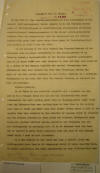
|
26.
July 9, 1929. G-2 Report on
Sandino's Trip to Mexico, Major
Fred T. Cruse, Military Attaché, San José, p. 1.
"SANDINO’S
TRIP TO MEXICO. ¶ On the 17th of
June Sandino, accompanied by
four lieutenants of his General
Staff, unexpectedly turned
himself in to the Honduran
border guard at CHICHICASTE,
east of Danlí. Following
instructions previously
received, General Sanchez,
commander of the border patrol,
immediately disarmed them and
communicated with his Government
and the Mexican Legation. The
group were taken under close
guard to Tegucigalpa, where they
arrived at 7:00 P.M. on the
20th. ¶ On the morning of the
21st General Max Vasquez,
Director of Police, took them in
closed automobiles to San
Lorenzo, thence to La Union by
launch. A representative of the
Mexican Legation accompanied
them. At La Union their arms
were returned to them and they
were received by a member of the
Mexican Legation and several
Salvadorean Army officers. By
this time Sandino was very much
alarmed, as during the whole of
the trip across Honduras he was
treated strictly as a criminal,
Furthermore he had been told
that the Mexican Minister in
Salvador was very pro-American.
¶ Source--Tenorio. ¶ At La Union
he was cordially received and a
special car was put on to a
freight train for him and his
lieutenants. The party
disembarked the next morning
about nine at Ilopango, about
eight miles from San Salvador.
Cars were waiting here to take
them to the railway that runs to
Santa Ana. Where this road
passes within about a mile of
the capital they were received
by the Minister of War, the
Chief of Aviation and the
Mexican Minister. At this point
the attached photographs were
taken, the Mexican Minister
having permitted one newspaper
man and one photographer to
accompany him. It is of interest
that the four men of Sandino’s
party check precisely with the
list of his General Staff which
I sent in last September. ¶ At a
way station on the Santa Ana
line a special train was
waiting, which took them to El
Congo, just short of Santa Ana.
From here, in closed automobiles
and still accompanied by Army
officers, they were . . . "
|
|
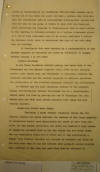
|
27.
July 9, 1929. G-2 Report on
Sandino's Trip to Mexico, Major
Fred T. Cruse, Military Attaché, San José, p. 2.
" . . . driven to Candelaria, on
the Guatemalan frontier. Here
Sandino met a mining man he had
known for years and held a
private talk with him. This man
immediately sent me word,
through Mr. Cohen, that Sandino
had told him that he was going
to Mexico to talk with the
President about continuing the
campaign in Nicaragua, and that
he would return to the Segovias
in November, probably in a
Mexican Government plane. If a
few of such statements were to
be widely published I believe
the Mexicans would begin to
understand the type of man with
whom they are dealing. ¶ At
Candelaria they were received by
a representative of the Mexican
Legation in Guatemala and taken
by automobile to Zacapa. Further
details I do not know. ¶
Source--Mr. Cohen ¶ In all three
Republics Sandino’s passage was
known only to the Government and
the Mexican Legation until after
he had actually crossed into
Mexico when the Government of
Guatemala informed the American
Minister and the Mexican
Legation in Salvador permitted
the publication of the attached
newspaper articles and
photographs. ¶ As Sandino was
the last remaining remnant of
the original Sacasa revolution,
the Mexican Government has to a
considerable extent saved its
face by getting him out of
Nicaragua and into Mexico safe
and with some little prestige
left among the more Radical
element. ¶ Ammunition buried
near Murra. ¶ Yesterday I asked
General Anastacio Somoza why the
Liberal leaders had never
informed the Marines of the
large quantity of ammunition
buried near Murra, which was
known to have been procured for
the Sacasa revolution and which
was Sandino’s only source of
supply. He answered that he and
the others had not known there
was any ammunition there but if
there was it was undoubtedly a
supply that Toribio Tijerino had
secured in Honduras and which he
had held onto when he saw how
affairs were going. He seemed
considerably startled at the
idea and said that when he
returned to . . . "
|
|
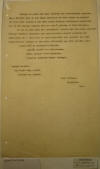
|
28.
July 9, 1929. G-2 Report on
Sandino's Trip to Mexico, Major
Fred T. Cruse, San José, p. 3.
" . . . Managua he would see
that Tijerino did considerable
explaining. I believe this is
the right answer, as we were
always up against the fact that
Sandino’s men were using
Honduran Government ammunition
and it was equally certain that
he wasn’t getting it from
Honduras. ¶ As can be seen from
the photographs Sandino and his
group traveled through Salvador
uniformed and armed, Sandino
himself carrying two automatics
and a belt full of cartridges.
This was probably the most
extraordinary feature of the
whole affair. The men with
Sandino were: ¶ Lieut. José de
Paredes----Mexican. ¶ Agustín
Martí------Salvadorean. ¶ Ruben
Ardila-------Colombian. ¶
Gregorio Guilbert--Santo
Domingo. ¶ Report No.462. ¶ San
José--July 9, 1929. ¶
Sources--as stated. ¶ Fred T.
Cruse, ¶ Major, G.S. ¶ M.A."
|
|
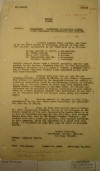
|
29. July 12, 1929.
G-2 Report on Press Propaganda in
Connection with Sandino, Lt.
Col. Gordon Johnston, Military
Attaché, Mexico City.
"G-2 Report ¶ 2900-b ¶ MEXICO ¶
SOCIAL ¶ SUBJECT: Propaganda:
Propaganda of Domestic Origin; ¶
Press Propaganda in Connection
with Sandino ¶ 1. General
Augusto César Sandino, the
leader of the rebel forces in
Nicaragua, arrived in Vera Cruz
June 28, 1929, accompanied by
his staff made up as follows: ¶
Lt. Col. Agustín F. Martí, a
Salvadorean, ¶ Lt. Rubén
Ardilla, a Colombian, ¶ Capt.
José Peredes, a Mexican, ¶ Lt.
Tranquilino Jarquín, a
Nicaraguan, ¶ Gregorio Gilbert,
a Dominican. ¶ Sandino entered
Mexico upon a tourist passport;
was met upon arrival by his
brother, Socrates Sandino; Sr.
José Constantino Gonzalez, a
reporter; and Dr. Pedro J.
Zepeda, a Nic. residing in
Mexico City, whom Sandino later
appointed as his official
representative. ¶ 2. Sandino
left Vera Cruz on July 8th for
Progreso, Yucatán, en route to
Mérida, by the steamer
“Superior”. This steamer is
operated by the Compañia Naviera
del Golfo, S.A., a Mexican
corporation owned by the
Moctezuma Brewery at Orizaba,
V.C., and is the same vessel on
which arms were shipped from
Puerto Mexico to Nicaragua in
the year 1926. No special
significance can be attached to
Sandino travelling on this
vessel, which is a small
coasting steamer used
principally by the owners to
transport beer to the various
ports along the Mexican coast. ¶
3. Sandino arrived in Progreso
on July 11th, accompanied by the
same staff above mentioned, and
proceeded the same day to
Mérida. ¶ 4. While in Vera Cruz
Sandino sent to Europe Sr. José
Constantino Gonzalez, to act as
his delegate to the Second
Congress of the
Anti-Imperialistic League which
is to be held at Frankfurt,
Germany, on July 22, 1929. This
delegate sailed from Vera Cruz
on the French steamer “Mexique”,
and carried with him a letter,
or protest, from Sandino
addressed to this Congress,
which was published in a local
Vera Cruz daily, “El Dictámen”,
on July 8th, copy of which is
attached hereto. ¶ Gordon
Johnston, ¶ Lieutenant Colonel,
Cavalry, ¶ Military Attaché. ¶
Source: Consular Report. ¶ J/p ¶
From: M.A.Mexico. ¶ Report No.
2489. ¶ Date: July 12, 1929."
|
|
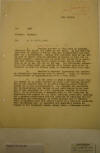
|
30.
July 5, 1929. G-2 Report on
Sandino, Lt. Col. Gordon
Johnston, Military Attaché,
Mexico City, p. 1.
"
... 1. Sandino arrived in Vera
Cruz on June 28, 1929, with his
staff, all armed to the teeth.
He had the full intention of
coming to Mexico City, and
arrangements had been made for a
celebration. Having been
informed that he was not to come
to Mexico City, he demanded
airplanes to take him to Mérida,
Yucatán, stating that he dared
not travel on an American boat
because they would either poison
him, or sink the ship so as to
get him out of the way.
The Government consented to his
delay until the arrival of a
French boat, which is expected
to sail for Mérida today or
tomorrow, from Vera Cruz.
¶ 2. Sandino's physical
appearance has created an
unfavorable impression here in
Mexico. Small in stature,
insignificant in appearance, and
with a weak voice. ¶ 3.
In the press of July 2 Sandino
states that his object is to
place himself in touch with
foreign nations who do not
realize that he is still
fighting, since Turcios ceased
to be his representative.
Dr. Machado was appointed his
representative but failed to act
satisfactorily; so that now he
has appointed Dr. José Zepeda,
who resides in Mexico City.
He is publishing a document,
sent to the President of
Argentina, with copies to all
Latin American countries,
calling for a general conference
for the purpose of securing the
indepenence and sovereignty of
these nations and to further
their friendshp with the United
States on a basis of equality.
This conference also to consider
the important points in regard
to the Nicaraguan Canal; among
these, Nicaragua should ... "
|
|
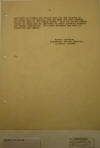
|
31.
July 5, 1929. G-2 Report on
Sandino, Lt. Col. Gordon
Johnston, Military Attaché,
Mexico City, p. 2.
"
... not sell the rights but
retain them for the freedom of
the Canal for all nations, and
not make the same mistake as in
the case of the Panama Canal.
Also the United States should be
bound not to intervene in Latin
American affairs nor foment
revolution. The above
document was sent to Argentina
last month. /s/ "
|
|
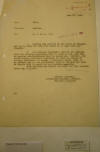
|
32. June 28, 1929.
G-2 Report on Sandino, Lt. Col.
Gordon Johnston, Military
Attaché, Mexico City.
"
Sandino has arrived in the State
of Chiapas, and is en route to
Vera Cruz where he is take ship
for Yucatan. ¶ 2.
The Mexican Government assures
the Embassy that the original
agreement will be carried out,
and that no popular
demonstrations will be
permitted. However, Don
Julio Sierra, Assistant
Secretary of State in Charge of
Foreign Relations, in making a
statement today, said in an
offhand way at the conclusion,
that if Sandino did come to
Mexico City it would be in a
private capacity. ..."
|
|
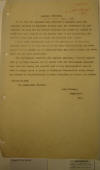
|
33. June 27, 1929.
G-2 Report on Sandino Situation,
Major Fred T. Cruse, Military
Attaché, San José.
"SANDINO SITUATION. ¶ On the
25th the Legation here received
a cablegram from the American
Minister in Guatemala stating
that the Government had just
informed him that the day before
officials had picked up Sandino
at Morán, the first station on
the railway west of the capital,
had put him on a train and seen
him cross the frontier into
Mexico. ¶ I have since
ascertained that he was
accompanied by four men,
although there is no hint yet as
to who they were. Yesterday the
newspapers here, or rather one
of them, published the news. I
attach the item, which was not
even head-lined. ¶ From
information received from
various quarters, I believe
Sandino will go to Vera Cruz,
and not to Mexico City. Two
Nicaraguans here, who were with
him during the earlier part of
his campaign, have told me that
he always spoke of going to
Merida, in Yucatan. Both these
places are centers of
radicalism, and he would
certainly be welcome in either.
¶ Report No.454. ¶ San
José--June 27, 1929. ¶ Fred T.
Cruse, ¶ Major, G.S. ¶ M.A."
|
|
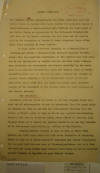
|
34. April 29,
1929. G-2 Report on Sandino
Situation, Major Fred T. Cruse,
Military Attaché, San José, p.
1.
"SANDINO SITUATION. ¶ The
original Sandino situation, the
one which might have kept the
United States in trouble with
Latin America for years, has
ceased to exist. Sandino, as a
Latin-American hero fighting the
whole power of the United States
as represented by the Marines,
is finished. The jolt that did
his heroic standing the most
harm was the reports made by the
commanders of Moncada’s three
volunteer forces after their
first campaign in Nueva Segovia.
¶ Of these three commanders
Escamilla is a Mexican, Plata a
Honduran, and Flores a
Nicaraguan. All three, in
separate reports, stated that
the appalling destruction in the
Segovias had been done, not by
the Marines, but by Sandino and
his men: that these outrages
were senseless and unnecessary
and clearly committed by the
worst kind of bandits: and
finally that since the Chipote
fight in December, 1927, SANDINO
AND HIS MEN HAD NOT BEEN
FIGHTING THE MARINES AT ALL, BUT
SIMPLY HARRYING A LOT OF
DEFENSELESS PEOPLE OF HIS OWN
RACE. There is no doubt that all
three commanders were genuinely
shocked at the condition of the
country which had been occupied
by the Sandino element. ¶ New
Situation. ¶ Sandino’s original
cause has blown up and his
original force harried out of
existence, but it must be
remembered that his great enemy
is Moncada and that he now has
the discontented elements of a
defeated political party to draw
on in his war against him.
Certainly Moncada will have to
continue making every effort to
actually kill him, but there is
no reason why Marines should be
in any way concerned in this,
except incidentally, as members
of the Guardia. ¶ Finally,
Tenorio informs me that as late
as March 25th Sandino was still
near Murra and with every
intention of remaining there as
long as he could. Tenorio’s
informant was Teresa Villatoros
[Teresa Villatoro],
who had just left him and come
to Tegucigalpa. Teresa also said
that the word was being spread
that Sandino would begin an
active campaign against Moncada
in May. This is pure talk, of
course. . . . "
|
|
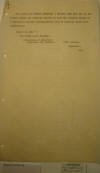
|
35. April 29,
1929. G-2 Report on Sandino
Situation, Major Fred T. Cruse,
Military Attaché, San José, p.
2.
" . . . As a guide for future
reference I believe that from
now on the United States can
consider Sandino as just the
possible leader of a revolution
against Moncada, should such an
unlikely thing ever materialize.
¶ Report No.119. ¶ San
José--April 12, 1929. ¶
Evaluation of news from
Nicaragua and Tenorio. ¶ Fred T.
Cruse, ¶ Major, G.S. ¶ M.A."
|
|
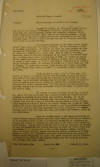
|
36. January 13,
1928. G-2 Short Biography of
Bandit Leader Sandino, Report
No. 223, Clerk Alex A. Cohen, in
the absence of the Military
Attaché, Costa Rica, p. 1.
"Augusto C. Sandino, the
Nicaraguan bandit leader, was
born in the village of Niquihomo
(sometimes called La Victoria),
Nicaragua, the son of Gregorio
Sandino and Margarita Calderon.
He is about thirty years of age.
Until 1921 he was entirely
unknown. In the latter
year he got into a fight,
wounding his adversary in the
leg with a pistol shot. He
had to flee Nicaragua and went
to Honduras, arriving there
about the middle of 1921.
¶ He obtained employment
in the shops of the
"Montecristo” sugar mill, near
La Ceiba, Honduras. For
the remainder of 1921 he
remained in Honduras. In
1922 he was taken ill with
malaria and left Honduras for
Guatemala. He arrived in
Puerto Barrios, Guatemala, where
he worked as a laborer for a
short time. Next he went
to Quirigua, Guatemala, where he
obtained employment in the shops
of the United Fruit Co.,
remaining there until the
beginning of 1923. He
worked his way on an oil tanker
from Puerto Barrios to Yucatan,
Mexico, where, in Merida, he
opened a small shop. It is
here that Sandino commenced to
be influenced by socialist
ideas. He remained in
Merida for a short while and
went to Tampico. He worked
for a short period in the oil
fields, thereafter going to
Mexico City, where he worked as
a mechanic’s helper during the
year 1924. ¶ Early
in 1925 he made a trip to
Nicaragua. His father met
him at a railroad station near
Niquihomo, warning him not to
come home as the case against
him for wounding his adversary
was still pending. Local
political influence had been
brought to bear to bring the
case up again in case of his
return, as Sandino was a Liberal
and his adversary had been a
Conservative.
Notwithstanding the case against
him, however, Sandino with an
air of bravado visited his home,
remaining there for several
days. ¶ He decided
to leave Nicaragua again and,
while on his way to the port of
Corinto met a person in Leon who
offered him employment as
mechanic in San Albino mine in
Nueva Segovia. He was at
this mine at the time the
Chamorro coup took place, in
August, 1925. Sandino then
made up a band of followers and
commenced a period of guerrilla
warfare in order to (in his own
words) "avenge the regime of
persecutions and terror
inflicted by the forces of the
Conservative Government."
It is here that his military
experience as leader commenced.
He waylaid patrols, took their
arms away from them and baffled
the Chamorro forces by his
elusiveness. ¶ Upon
the establishment of the Sacasa
government at Puerto Cabezas
Sandino appears upon the scene
there, offering his services.
It is understood that at that
time General Moncada had no
confidence in Sandino and
refused to furnish him with guns
at the time of the battle of
Pearl Lagoon. Sandino kept
insisting that he and his
followers be furnished arms and
ammunition and finally obtained
an order for forty rifles and
ammunition, to be turned over to
him at Cabo Gracias a Dios.
However, after the battle of
Pearl Lagoon Sandino had already
picked up a certain number of
rifles and ammunition which were
left behind by the forces of
General Rivers Delgadillo and
armed with these rifles he and
his followers proceeded to the
mouth of the Segovia river, near
the Horduras frontier and
commenced his march inland. . .
."
|
|
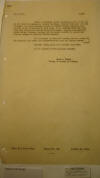
|
37. January 13,
1928. G-2 Short Biography of
Bandit Leader Sandino, Report
No. 223, Clerk Alex A. Cohen, in
the absence of the Military
Attaché, Costa Rica, p. 2.
" . . . After a difficult march,
proceeding part of the way up
the river in canoes he arrived
at Bocay. Here he arms
more men and continues his march
inland, shortly thereafter
taking Jinotega, the capital of
the department by that name.
This occurred about the same
time that Moncada was advancing
upon Matiguas. Sandino
continued his march inland,
burning, looting and pillaging
wherever he passed and finally
managed to join the Moncada
forces. ¶ The
remainder of Sandino’s career,
how he refused to lay down his
arms after the Stimson-Moncada
pact are already known. ¶
Source: Daily press and
reliable informant."
|
|
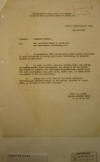
|
38. May 10, 1930.
G-2 Report on Gregorio Sandino,
Major Thos. T. Handy, Canal
Zone.
"HEADQUARTERS PANAMA CANAL
DEPARTMENT ¶ Office of the
Assistant Chief of Staff, G-2. ¶
Quarry Heights, Canal Zone. ¶
May 10, 1930. ¶ Subject:
Gregorio Sandino. ¶ To: The
Assistant Chief of Staff, G-2, ¶
War Department, Washington, D.C.
¶ 1. In connection with report,
dated April 4, 1930, forwarded
to your office, the following
additional information on
Gregorio Sandino is forwarded: ¶
2. On April 29, 1930, Gregorio
Sandino, white and America De
Sandino, white, both
Nicaraguans, who claim to be the
father and mother of Sandino,
the Nicaraguan revolutionist,
sailed from the port of
Cristobal for Port Limon, Costa
Rica, as first class passengers
on the SS Stuyvesant. ¶ 3.
During the visit here of the
above mentioned individual, he
visited several of the medical
clinics in Panama City, on
account of his wife’s health. ¶
THOS. T. HANDY, ¶ Major, General
Staff, ¶ A. C. of S, G-2"
|
|
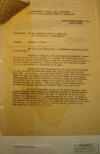
|
39. April 4, 1930.
G-2 Report on Gregorio Sandino,
Major Thos. T. Handy, Canal
Zone.
"HEADQUARTERS PANAMA CANAL
DEPARTMENT ¶ Office of the
Assistant Chief of Staff, G-2. ¶
Quarry Heights, Canal Zone. ¶
April 4, 1930. ¶ MEMORANDUM: To
The Assistant Chief of Staff,
G-2, ¶ War Department,
Washington, D.C. ¶ Subject:
Gregorio Sandino. ¶ The
following information in
reference Gregorio Sandino is
forwarded: ¶ Gregorio Sandino,
61, white, Nicaraguan,
occupation farmer, accompanied
by his wife America de Sandino,
50, white, Nicaraguan, arrived
at Balboa from Corinto, on board
the SS HELUAN, March 18, 1930,
as first-class passengers.
Sandino stated to the boarding
officer that he would return to
Nicaragua in 15 days. ¶ Sandino
and wife registered at the Hotel
Centro America on same day they
arrived here under the name of
GREGORIO AMERICA AND WIFE. He
stated to the management of the
hotel that he registered under
the name of America because he
was the father of Sandino, the
revolutionist, and did not want
any publicity while on the
Isthmus; that he was here to
enjoy himself and wanted to see
some of the interior around Agua
Dulce. The management of the
Centro America stated that
Sandino had had no visitors
while stopping there. ¶ On March
22 Sandino called at the Chase
National Bank, Panama City, and
cabled $200.00 to Socrates
Sandino at Merida, Mexico. This
transaction went through the
Bank of Montreal in Mexico City.
Sandino was accompanied by a
women [woman], supposedly his
wife. He holds a letter of
credit issued by the Anglo-South
American Bank in Managua; and
reported to be for $1200.00. He
stated to an employee of the
bank that he was the father of
Socrates Sandino and of Agusto
Sandino, the Nicaraguan
revolutionary leader."
|
|
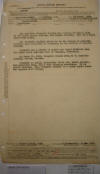
|
40. March 28,
1930. Confidential
G-2 Intelligence Report on Mr. &
Mrs. Gregorio Sandino, Major D.
Peck, USMC, Special Service
Squadron, Balboa, C.Z.
"Mr. and Mrs. Gregorio Sandino
are staying in Panama City at
the Hotel Centro America, 149
Avenue Central. This is a small
third rate hotel. ¶ Mr. Gregorio
Sandino claims to be the father
of Socrates Sandino, who,
according to Gregorio, is the
brother of General Sandino. ¶
Gregorio has a letter of credit
for about $1200.00 from the
Anglo South American Bank of
Managua, Nicaragua. ¶ On March
22, 1930, Gregorio cabled
$200.00 to Socrates Sandino,
Merida, Mexico. ¶ Gregorio is
small, moderately thick set,
wears glasses, has yellowish
skin, and a thin drooping
moustache. He is poorly dressed.
Mrs. Gregorio Sandino is a dowdy
squat woman who appears half
Indian."
|
|
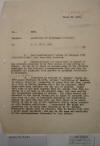
|
41. March 21,
1930. Confidential G-2 Report
on Activities of Nicaraguan
Aviators, Lt. Col. Gordon
Johnston, Military Attaché,
Mexico City, p. 1.
"March 21, 1930. ¶ No.- 2820. ¶
Subject: Activities of
Nicaraguan Aviators. ¶ To: A. C.
of S., G-2 ¶ 1. Your
“Confidential” letter of
February 27th (G-2/2657-P-241),
has been duly received. ¶ 2.
Investigations are being made in
regard to the aviators reported
to be from Mexico or now living
in Mexico. So far as is known at
present, none of the aviators
mentioned in the attached
correspondence from the Navy
Department are connected with
present or proposed activities
in Nicaragua. ¶ 3. Attention is
invited to “Secret” report No.
2783, dated February 28, 1930,
subject “Activities of Sandino
in Mexico City, etc.” regarding
an order that had been placed by
a firm in Mérida, Yucatán, for a
300 HP airplane, which might
have been intended for the use
of Sandino. Since that time it
has been learned that Sr. Montes
(the firm referred to), as well
as his several sons, are very
wealthy and responsible citizens
of Mérida. The elder Montes was
educated in the United States,
and is known to business circles
here as a man of excellent
character and reputation. People
who know him very well say that
there is no possibility of him
or any of his immediate family
being connected with Sandino
activities. I understand the
plane was purchased and is being
used personally by Sr. Montes.
Newspapers report that he
recently flew to Mexico City
with a pilot named Garibaldi,
who may be the same man
mentioned in the correspondence
forwarded to this office. . . .
"
|
|
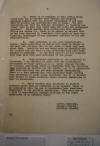
|
42. March 21,
1930. Confidential G-2 Report
on Activities of Nicaraguan
Aviators, Lt. Col. Gordon
Johnston, Military Attaché,
Mexico City, p. 2.
" . . . 4. There is no evidence
in this office which would lead
one to believe that Sandino had
received material support from
the Mexican Government or had
been able to collect any
considerable sum of money. The
probabilities are that the
Mexican Government is “nursing
him along” just in case they
might need him later for
propaganda purposes. While
Sandino held conferences with
General Calles and Portes Gil,
there is no reason to believe
that he has been received by
President Ortiz Rubio, or been
particularly encouraged by any
prominent official of the new
Administration. ¶ 5. With
reference to the
Anti-Imperialistic League, their
activities in Mexico have been
so slight in the past year or
more that no one seems to know
very much about them. Inquiries
are now being made to ascertain
who the leaders are, and what if
any, activities they have been
engaged in recently. In the past
year it is not recalled that
they have even been mentioned in
the press. ¶ 6. From personal
knowledge of the situation in
Nicaragua, I am inclined to
agree with the Confidential
Memorandum of Major Rowell,
U.S.M.C. dated January 28, 1930.
No airplane operations could be
conducted from the territory
then occupied by Sandino and the
rebels, and it is understood
that this territory has not been
extended subsequently. There is
a bare possibility that
airplanes might operate from
Guatemala or Costa Rican
territory, but it is doubted
that either of these countries
would involve themselves in such
an enterprise. ¶ 7. While
Sandino made overtures to
certain aviators while here, as
contained in my reports, there
is no indication that the men so
approached have committed
themselves to any definite
enterprise. They were not of a
type to successfully conduct
military or any other operations
on an extended scale. ¶ Gordon
Johnston, ¶ Colonel, Cavalry, ¶
Military Attaché. ¶ J/p"
|
|
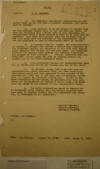
|
43. March 10,
1930. Secret G-2 Report
No. 2797 on C. A. Sandino, Col.
Gordon Johnston, Military
Attaché, Mexico City, p. 1.
"G-2 Report ¶ MEXICO ¶ SUBJECT:
C. A. Sandino. ¶ 1. The
following significant
information was received today
by the M/A from a reliable
American, with reference to
Sandino. ¶ 2. This American is
an old friend of General Mora
who has recently become Chief of
the Presidential Staff. He used
his influence with General Mora
to have placed on the
Presidential Staff a young
officer in whom he is very much
interested. Last week this
officer told the American that
he had been going over the
archives of the Presidential
Staff and was surprised to find
an ‘expediente’ (file) on
Sandino. ¶ 3. It appears that
Dr. Zepeda, the representative
of Sandino in Mexico, had
written a letter last September
to the President calling his
attention to the fact that
certain money promised for
Sandino had not been paid. The
President directed the payment
made through the Treasury
Department and charged to “War
Expenses”. Between September
12th and 19th, 1929, $4,000
pesos was paid to Sandino,
through Dr. Zepeda, out of the
above-mentioned funds. ¶ 4.
Also, Government passes for
transportation from and to
Mérida, were issued for Sandino
and two of his staff. ¶ 5. The
officer stated that there had
been no correspondence since
September 19th, but that
ordinarily this matter would not
have appeared in the records of
the Presidential Staff had it
not been for the personal letter
from Dr. Zepeda to President
Portes Gil. So far as the
above-mentioned officer knows,
no payments have been made since
the inauguration of President
Ortiz Rubio,- at least none are
shown in the records of the
Presidential Staff. ¶ 6. The
above information needs no
comment as it indicates quite
clearly that heretofore payments
have been made to Sandino
through the War Department and
Treasury, by direction of the
President. ¶ Gordon Johnston, ¶
Colonel, Cavalry, ¶ Military
Attaché. ¶ Source: As stated. ¶
J/p ¶ From: M.A.Mexico. ¶ Report
No. 2797. ¶ Date: March 10,
1930."
|
|
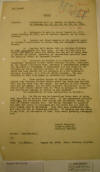
|
44. February 28,
1930. Secret G-2 Report on
Activities of C. A. Sandino in
Mexico City on February 20, 21,
22, 23, 24, 25, 26, 1930, Report
No. 2783, Col. Gordon Johnston,
Military Attaché, Mexico City,
p. 1.
"G-2 Report ¶ MEXICO ¶ SUBJECT:
Activities of C. A. Sandino in
Mexico City, on February 20, 21,
22, 23, 24, 25, 26, 1930. ¶ 1.
Reference is made to Secret
Report No. 2776 dated February
21, 1930, and to earlier
reports, on the above subject. ¶
2. Further and final reports of
the special agent on Sandino’s
activities in Mexico City are
forwarded attached hereto. ¶ 3.
Sandino left Mexico City on
Saturday, February 22, 1930, for
Mérida via Vera Cruz. He went to
Vera Cruz by train, and as
reported left by plane for
Mérida but was not on board when
it arrived at Mérida, according
to information received from the
American Consul at Progreso,
Yucatán. ¶ 4. Attention is
invited to a report of the State
Department (despatch No.984)
dated February 20, 1930,
addressed to the Chargé
d’affaires here, covering a
conversation between the
Minister of Nicaragua in
Washington and the Chief of the
Division of Latin American
Affairs, to the effect that an
order had been placed for the
purchase of a 300 horsepower
military airplane, by a firm in
Mérida, Yucatán. The presumption
is that this plane is intended
for Sandino. ¶ 5. From another
source of information it is
reported that Sandino visited
Calles about two weeks ago and
was with him for more than two
hours. The results of this
conference are not known, but
the most reliable information is
to the effect that Calles stated
that he “will do nothing to
hamper any activities started in
Mexico to aid Sandino”. ¶ The
reliability of this information
is doubtful. ¶ 6. So far as can
be learned, no large sums of
money were received by Sandino
while here. He has approached
aviation officers, and
ex-General Juan Merigo and
ex-General Arvízu, as well as
ex-General Claudio Fox. The
latter declined to consider his
plan for going to Nicaragua, but
the other two are said to have
looked upon it favorably. Both
have been eliminated from the
Army and are in financial
straits. If Sandino has any
money to pay them, or assurance
of loot, they would probably
accompany him. . . ."
|
|
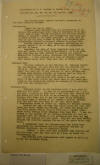
|
45. February 28,
1930. Secret G-2 Report on
Activities of C. A. Sandino in
Mexico City on February 20, 21,
22, 23, 24, 25, 26, 1930, Report
No. 2783, Col. Gordon Johnston,
Military Attaché, Mexico City,
p. 2.
" . . . Activities of C. A.
Sandino in Mexico City, ¶
February 20, 21, 22, 23, 24, 25,
and 26, 1930. ¶ The special
agent reports Sandino’s
movements on the above dates as
follows: ¶ February 20: ¶ “Spent
the day as usual. ¶ Everyone
seems worried over the
intervention of the Mexico City
police, and their reserve
increases every day. Martí told
me that Esteban Pavletich, the
Peruvian writer, member of
Sandino’s staff,, who
disappeared some days ago, is
under arrest in the local
garrison. He also told me that
no one had been allowed to talk
with Pavletich, notwithstanding
Sandino’s personal efforts to
secure this. ¶ Sandino promised
to give important information
tomorrow; unable to do so today
as he had an appointment and had
to leave. ¶ Regarding the date
of their departure, they tell me
they are making their final
preparations. It is my opinion
that they are only waiting to
collect the sum of twenty-five
thousand pesos, necessary for
their travelling expenses. I
have noticed that none of
Sandino’s staff have lacked
money while they have been in
Mexico City. ¶ January 21st: ¶
“Sandino remained in his
Balderas St. lodgings nearly all
the morning. He then went out
with Gen. Estrada and others of
his staff, and had not returned
at 8 p.m. I understand they went
out to say good-bye to their
friends and arrange some pending
details, as Paredes told me they
expect to leave tomorrow night
for Vera Cruz. ¶ During my
conversation with Paredes he
told me that while he was under
arrest for three days in the
local garrison he ate absolutely
nothing on account of the
wretched food that was offered
him. ¶ February 22d. ¶ “Sandino
stayed in his lodgings until 1
p.m., when he went out for
lunch. He gave me an appointment
for 4 p.m., but when I arrived
at that hour I was told that
Sandino and his aides had left
at 3:30 in an automobile taking
their luggage with them, but it
was not known by my informant,
the young lady in charge of Dr.
Zepeda’s office, whether they
had left for Vera Cruz or for
some other point. I immediately
tried to locate Dr. Zepeda, but
without success. ¶ Sandino had
told me that they would leave
for Vera Cruz today, and there
embark for Mérida, but since the
train for Vera Cruz leaves
Mexico City at 8:25 p.m. I
cannot understand their leaving
their lodgings when they did. I
was informed in the offices of
Mexican Aviation Co. that no
airplane left for Mérida in the
afternoon, but that one had left
in the morning for that port.
They did not know whether
Sandino had reserved passage for
any of the ports which they
touch. ¶ I understand that the
International Red Cross have
petitioned the Government for
the immediate release of Esteban
Pavletich, one of Sandino’s
aides. ¶ (Later) I have just
been informed that Sandino and
all his aides left for Vera Cruz
at 5 p.m. on board the
Interoceanic Ry. ¶ Gen. Sandino
left instructions with Zepeda to
allow me to see his personal
files. . . . "
|
|
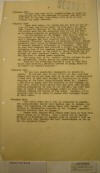
|
46. February 28,
1930. Secret G-2 Report on
Activities of C. A. Sandino in
Mexico City on February 20, 21,
22, 23, 24, 25, 26, 1930, Report
No. 2783, Col. Gordon Johnston,
Military Attaché, Mexico City,
p. 3.
" . . . February 23rd: ¶ “I have
been both to Dr. Zepeda’s home
in Lomas de Chapultepec and to
his Balderas St. office, and
have not been able to see him;
they always tell me he is out. I
shall try again tomorrow. ¶
February 24th: ¶ “Same luck
today; Dr. Zepeda has not been
at his office all day, nor at
his home. At 8:30 p.m., the last
time I went to Balderas St. the
young lady in charge of his
office said she was surprised
that he had not come, as he
always attended to patients
between 6 and 8 p.m. ¶ “In the
offices of ‘La Prensa’ they have
no news of the arrival of
Sandino at Vera Cruz or at
Mérida, but said a telegram had
been received from the Congress
Estudiantil (Students’ Congress)
of Monterrey (Mexico) asking
President Ortiz Rubio to
immediately withdraw recognition
of General Moncada’s Government
in Nicaragua. They told me that
said Congress had received a
letter from Sandino informing
them of his campaign against
‘Yankee imperialism’ and that he
trusted in the youth of Latin
America for the triumph of Latin
American ideals; that when that
letter was received it evoked
great applause. ¶ The young lady
in Dr. Zepeda’s office refuses
to give any information, simply
saying she knows nothing. ¶ From
all the foregoing Sandino’s trip
to Vera Cruz would seem
doubtful; possibly instead of
going there he is headed for
Central America.” ¶ February
25th: “It has been absolutely
impossible to locate Dr. Zepeda.
He has not been to his office
all day, and they always tell me
at his home that he is not in.
Neither have I been able to talk
with General De Nogales, who is
still stopping at the Hotel
Regis, although never in.
However, I was able to learn
that the reporter on the
“Prensa”, in Vera Cruz, called
their office here and said that
General Sandino, accompanied by
some of his friends, had left
Vera Cruz on board a train for
Jalapa (State of Vera Cruz),
without stating the object of
his trip. However, it is
probable that he is going to
confer with Governor Tejeda of
that State. ¶ February 26th: ¶
“Not until today was I able to
interview Dr. Zepeda, who
categorically denies that
Sandino went to Jalapa, but says
‘the reporters are seeing Moors
with lances”. (According to
information received by the
‘Prensa’ reporter, Sandino
actually went to Jalapa.) ¶
Zepeda says Sandino will remain
some days in Vera Cruz before
going on to Mérida. When I asked
him if Sandino would go to
Nicaragua he replied that he
couldn’t tell me. He also said
that Sandino had left
instructions to let me see his
personal files."
|
|
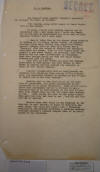
|
47. February 19,
1930. Secret G-2 Report on
Activities of C. A. Sandino in
Mexico City, Col. Gordon
Johnston, Military Attaché,
Mexico City.
"C. A. Sandino. ¶ The special
agent reports Sandino’s
movements on February 19, 1930,
as follows: ¶ “The Sandino group
still expect to leave Mexico
City at any moment. ¶ At seven
o’clock this evening Sandino was
in conference with a man whose
name I could not learn; but he
has made an appointment for me
to call at noon tomorrow (Feb.
20) for a long talk. ¶ I learned
today that at the dinner given
recently to Sandino by the
lawyer Isidro Fabela, an
incident occurred which made
Sandino very angry with Fabela.
General Estrada tells me that
this dinner was a ‘frame-up’
with the object of finding out
Sandino’s intentions and plans.
That at this dinner there was
present a man named Moreno, an
American, with whom Sandino had
had some altercations in
Nicaragua; that when Sandino
found out what was up, he became
furious and left the place. ¶
They tell me that Fabela was
once the Mexican Ambassador at
Washington, and that Moreno is
well known in Central America
through his exploits in favor of
Wall Street bankers. ¶ General
Estrada also told me that
Paredes was released this
afternoon from custody of the
authorities, and presented
himself to Sandino at six
o’clock to report how he had
been treated. ¶ Paredes says he
was first taken to the Jefatura
of Operations, and later
transferred to the Guarnición de
la Plaza (Garrison). That at the
latter place they questioned him
as to whether he was a communist
and if he knew anybody on the
list of persons they showed him;
but all the names were unknown
to him. That during the time he
was under arrest they gave him
very bad food to eat, but did
not submit him to torture. ¶
Paredes says that while he was
detained in the Garrison he made
efforts to learn if Pavletich
was also there, but could not
locate him. Therefore
Pavletich’s whereabouts
continues a profound mystery,
although Sandino’s friends
suspect that he is under arrest
at the Garrison."
|
|
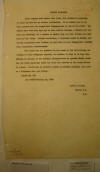
|
48. February 19,
1930. G-2 Report on Sandino
Situation, Report No. 667, Major
Fred. T. Cruse, Military
Attaché, San José.
"SANDINO SITUATION ¶ Press
reports from Mexico City state
that Sandino is preparing to
leave Yucatan for an unknown
destination. It is stated that
he is much alarmed over the
unexplained disappearance of two
of his Staff. The report says
that some days ago he sent José
de Paredes, a Mexican who has
been his Secretary, on a mission
to Mexico City and that nothing
has been heard of him since.
Esteban Pavletvich, a Communist
Agent in Mexico, and closely
identified with Sandino, is said
also to have disappeared
recently under misterious
[mysterious] circumstances. ¶
Both these men are probably in
the hands of the authorities,
according to other newspaper
reports, but Sandino is said to
be very suspicious on account of
the previous disappearance of
Agustín Martí, which was not
taken seriously until the other
two members of his Staff failed
to return. Pavletvich is
generally known as Esteban
Castillo, and poses as a
Colombian Poet and Writer. ¶
Report No. 667 ¶ San
José--February 19, 1930 ¶ Fred
T. Cruse, ¶ Major, G.S. ¶ M.A."
|
|
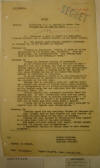
|
49. February 19,
1930. Secret G-2 Report on
Activities of C. A. Sandino in
Mexico City, February 16, 17,
and 18, 1930, Lt. Col. Gordon
Johnston, Military Attaché,
Mexico City.
"G-2 Report ¶ MEXICO ¶ SUBJECT:
Activities of C. A. Sandino in
Mexico City, February 16, 17,
and 18, 1930. ¶ 1. Reference is
made to report No. 2765, dated
February 18, 1930, and to
earlier reports, on the above
subject. ¶ 2. The special agent
reports Sandino’s movements on
February 16, 17 and 18, 1930, as
follows: ¶ February 16: ¶
“Nothing of importance. Nothing
is known as to the whereabouts
of the missing man, Pavletich.
They are distrustful, and
uncommunicative. This evening
they went to their secret
meeting, as usual.” ¶ February
17: ¶ “During the forenoon
nothing of importance. ¶ At six
o’clock this afternoon I was
able to have a moment’s talk
with Sandino, who told me that
yesterday another member of his
staff had disappeared
mysteriously,- Capt. José De
Paredes, a Mexican and an old
comrade of his, since Paredes
was one of the number who fought
against the Americans in
Nicaragua. ¶ Up to now nothing
is known as to the whereabouts
of either Paredes, nor of
Pavletich, the Peruvian writer
who was arrested on the 13th
inst. ¶ Sandino told me
personally that Col. Agustin
Martí was arrested, and placed
at liberty after being subjected
to an interrogatory by the
police authorities, as to
whether the Sandino group had
any relations with the Russian
Minister, Makar, etc. ¶ Sandino
appears much concerned regarding
these two missing men. He said
‘Fortunately they were not
armed, as otherwise there might
be serious consequences.’. He
also remarked that he wouldn’t
be surprised if he were shot one
of these days, when going round
a corner. ¶ I asked him if he
still expected to leave soon,
and he replied that all depends
upon circumstances.” ¶ February
18: ¶ “Sandino spent the day
receiving friends, at Balderas
24. ¶ Gen. Estrada told me that
Paredes had been located, at the
local Garrison, where he was
still in custody. ¶ Nothing had
been learned of Pavletich, but
they suspect he is also being
held at the said Garrison. ¶ Not
known yet, when Sandino will
leave,- always answering that
‘it depends upon circumstances’.
¶ I understand Sandino is taking
steps to have Paredes released.”
¶ J/p ¶ Gordon Johnston, ¶
Colonel, Cavalry, ¶ Military
Attaché. ¶ Source: As stated. ¶
From M.A.Mexico. ¶ Report
No.2771. ¶ Date: Feb. 19, 1930."
|
United States National Archives, Record Group
165, Entry 77, Box 2653.
|

